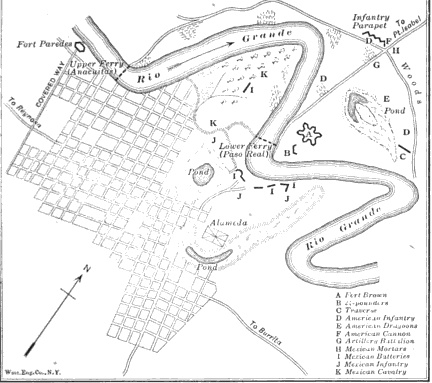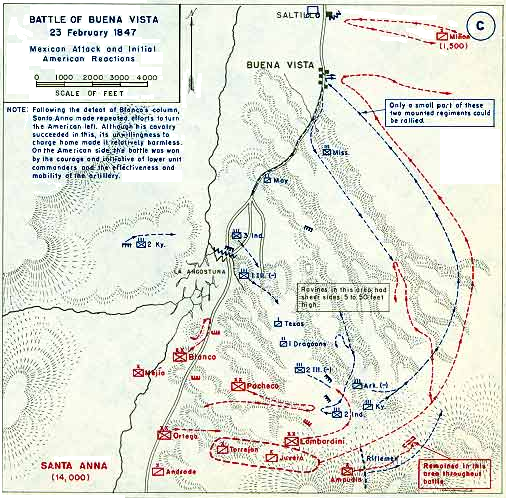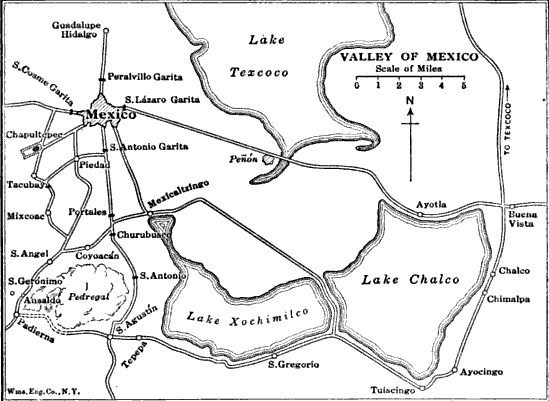|
Gen. Francisco Mejia
General Francisco Mejia was a Mexican general. He started his military career at the age of 15 in the Spanish colonial army. His first major battle was in Mexico's war of Independence in 1821 and he also fought when Spain invaded Mexico in 1829. The Battle of San Jacinto occurred in 1836 and was won by the Texans, allowing them to become an independent nation until they became part of the United States in 1845. Mejia was serving as a commander and was told to kill 200 Texans after they were defeated at Ciudad Mier in December 1842. He refused as he didn't feel like that was the correct punishment. Mejia chose to leave the army after the order but would return at a later time. Gen. Francisco Mejia is mostly known for his proclamation against Texas written in Matamoros, March 18, 1846. It states the dispute over land is a "scandalous violation of the rights of nations" and that "dissimulation, fraud, and the basest treachery" had been employed "in order to obtain possession ... ... [...More Info...] [...Related Items...] OR: [Wikipedia] [Google] [Baidu] |
Mexican War Of Independence
The Mexican War of Independence ( es, Guerra de Independencia de México, links=no, 16 September 1810 – 27 September 1821) was an armed conflict and political process resulting in Mexico's independence from Spain. It was not a single, coherent event, but local and regional struggles that occurred within the same period, and can be considered a revolutionary civil war. Independence was not an inevitable outcome, but events in Spain directly impacted the outbreak of the armed insurgency in 1810 and its course until 1821. Napoleon Bonaparte's invasion of Spain in 1808 touched off a crisis of legitimacy of crown rule, since he had placed his brother Joseph on the Spanish throne after forcing the abdication of the Spanish monarch Charles IV. In Spain and many of its overseas possessions, the local response was to set up juntas ruling in the name of the Bourbon monarchy. Delegates in Spain and overseas territories met in Cádiz, Spain, still under Spanish control, as the Co ... [...More Info...] [...Related Items...] OR: [Wikipedia] [Google] [Baidu] |
Battle Of San Jacinto
The Battle of San Jacinto ( es, Batalla de San Jacinto), fought on April 21, 1836, in present-day La Porte and Pasadena, Texas, was the final and decisive battle of the Texas Revolution. Led by General Samuel Houston, the Texan Army engaged and defeated General Antonio López de Santa Anna's Mexican army in a fight that lasted just 18 minutes. A detailed, first-hand account of the battle was written by General Houston from the headquarters of the Texan Army in San Jacinto on April 25, 1836. Numerous secondary analyses and interpretations have followed. General Santa Anna, the president of Mexico, and General Martín Perfecto de Cos both escaped during the battle. Santa Anna was captured the next day on April 22 and Cos on April 24. After being held for about three weeks as a prisoner of war, Santa Anna signed the peace treaty that dictated that the Mexican army leave the region, paving the way for the Republic of Texas to become an independent country. These treaties did not ... [...More Info...] [...Related Items...] OR: [Wikipedia] [Google] [Baidu] |
Matamoros, Tamaulipas
Matamoros, officially known as Heroica Matamoros, is a city in the northeastern Mexican state of Tamaulipas, and the municipal seat of the homonymous municipality. It is on the southern bank of the Rio Grande, directly across the border from Brownsville, Texas, United States. Matamoros is the second largest city in the state of Tamaulipas. As of 2016, Matamoros had a population of 520,367. In addition, the Matamoros–Brownsville Metropolitan Area has a population of 1,387,985, making it the 4th largest metropolitan area on the Mexico–US border. Matamoros is the 39th largest city in Mexico and anchors the second largest metropolitan area in Tamaulipas. The economy of the city is significantly based on its international trade with the United States through the USMCA agreement, and it is home to one of the most promising industrial sectors in Mexico, mainly due to the presence of maquiladoras. In Matamoros, the automotive industry hosts the assembly and accessories plants fo ... [...More Info...] [...Related Items...] OR: [Wikipedia] [Google] [Baidu] |
Siege Of Fort Texas
The siege of Fort Texas marked the beginning of active campaigning by the armies of the United States and Mexico during the Mexican–American War. The battle is sometimes called the siege of Fort Brown. Major Jacob Brown, not to be confused with War of 1812 General Jacob Brown, was one of the two Americans killed in action. Background On 28 March 1846, the Army of Occupation under General Zachary Taylor reached the north bank of the Rio Grande. Taylor ordered Captain Joseph K. Mansfield to construct an earthen star fort for 800 men named "Fort Texas".Bauer, K.J., ''The Mexican War, 1846–1848'', New York: Mcmillan, The fort was garrisoned by 500 men under Major Jacob Brown, including the 7th Infantry, Capt. Allen Lowd's four 18-pounders, and Lt. Braxton Bragg's field battery. Mexican General Francisco Mejia's 2,000 men also erected similar fortifications, including for his twenty cannons, for 800 men upstream at the Las Anacuitas ferry crossing, called Fort Paredes; an ... [...More Info...] [...Related Items...] OR: [Wikipedia] [Google] [Baidu] |
Battle Of Monterrey
In the Battle of Monterrey (September 21–24, 1846) during the Mexican–American War, General Pedro de Ampudia and the Mexican Army of the North was defeated by the Army of Occupation, a force of United States Regulars, Volunteers and Texas Rangers under the command of General Zachary Taylor. The hard-fought urban combat led to heavy casualties on both sides. The battle ended with both sides negotiating a two-month armistice and the Mexican forces being allowed to make an orderly evacuation in return for the surrender of the city. Background Following the Battle of Resaca de la Palma, Taylor crossed the Rio Grande on 18 May, while in early June, Mariano Arista turned over command of what remained of his army, 2,638 men, to Francisco Mejia, who led them to Monterrey.Bauer, K.J., 1974, ''The Mexican War, 1846–1848'', New York: Macmillan, On 8 June, United States Secretary of War William L. Marcy ordered Taylor to continue command of operations in northern Mexico, ... [...More Info...] [...Related Items...] OR: [Wikipedia] [Google] [Baidu] |
Battle Of Buena Vista
The Battle of Buena Vista (February 22–23, 1847), known as the Battle of La Angostura in Mexico, and sometimes as Battle of Buena Vista/La Angostura, was a battle of the Mexican–American War. It was fought between the US invading forces, largely volunteers, under General Zachary Taylor, and the much larger Mexican Army under General Antonio López de Santa Anna. It took place near Buena Vista, a village in the state of Coahuila, about south of Saltillo, Mexico. ''La Angostura'' ("the narrow place") was the local name for the site. The outcome of the battle was ambiguous, with both sides claiming victory. Santa Anna's forces withdrew with war trophies of cannons and flags and left the field to the surprised U.S. forces, who had expected there to be another day of hard fighting. Background U.S. President James K. Polk had decided that an invasion into central Mexico via the Gulf Coast port of Veracruz would make the Mexicans come to the negotiating table. He told Major Ge ... [...More Info...] [...Related Items...] OR: [Wikipedia] [Google] [Baidu] |
Battle Of Contreras
The Battle of Contreras, also known as the Battle of Padierna, took place on 19–20 August 1847, in one of the final encounters of the Mexican–American War, as invading U.S. forces under Winfield Scott approached the Mexican capital. American forces surprised and then routed the Mexican forces of General Gabriel Valencia, who had disobeyed General Antonio López de Santa Anna's orders for his forces' placement. Although the battle was an overwhelming victory for U.S. forces, there are few depictions of it in contemporary popular prints. The armies re-engaged the next day in the Battle of Churubusco. Background General Gabriel Valencia's army of the north was part of the forces that fought at the Battle of Buena Vista in February 1847, in which Santa Anna retreated before giving a crushing blow to the forces of Zachary Taylor. The Mexican forces were then divided in two, with one sent to Cerro Gordo and the other to San Luis Potosí. General Valencia was given the command of ... [...More Info...] [...Related Items...] OR: [Wikipedia] [Google] [Baidu] |
Year Of Birth Missing
A year or annus is the orbital period of a planetary body, for example, the Earth, moving in its orbit around the Sun. Due to the Earth's axial tilt, the course of a year sees the passing of the seasons, marked by change in weather, the hours of daylight, and, consequently, vegetation and soil fertility. In temperate and subpolar regions around the planet, four seasons are generally recognized: spring, summer, autumn and winter. In tropical and subtropical regions, several geographical sectors do not present defined seasons; but in the seasonal tropics, the annual wet and dry seasons are recognized and tracked. A calendar year is an approximation of the number of days of the Earth's orbital period, as counted in a given calendar. The Gregorian calendar, or modern calendar, presents its calendar year to be either a common year of 365 days or a leap year of 366 days, as do the Julian calendars. For the Gregorian calendar, the average length of the calendar year (the mea ... [...More Info...] [...Related Items...] OR: [Wikipedia] [Google] [Baidu] |
Year Of Death Missing
A year or annus is the orbital period of a planetary body, for example, the Earth, moving in its orbit around the Sun. Due to the Earth's axial tilt, the course of a year sees the passing of the seasons, marked by change in weather, the hours of daylight, and, consequently, vegetation and soil fertility. In temperate and subpolar regions around the planet, four seasons are generally recognized: spring, summer, autumn and winter. In tropical and subtropical regions, several geographical sectors do not present defined seasons; but in the seasonal tropics, the annual wet and dry seasons are recognized and tracked. A calendar year is an approximation of the number of days of the Earth's orbital period, as counted in a given calendar. The Gregorian calendar, or modern calendar, presents its calendar year to be either a common year of 365 days or a leap year of 366 days, as do the Julian calendars. For the Gregorian calendar, the average length of the calendar year (the me ... [...More Info...] [...Related Items...] OR: [Wikipedia] [Google] [Baidu] |





